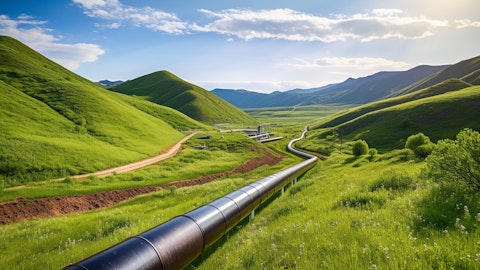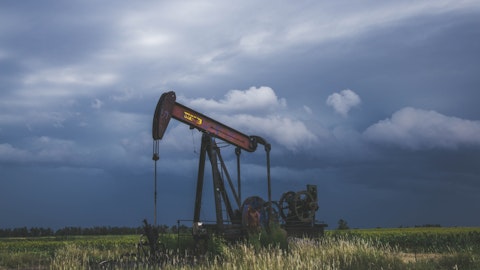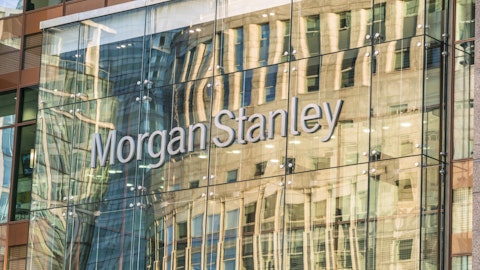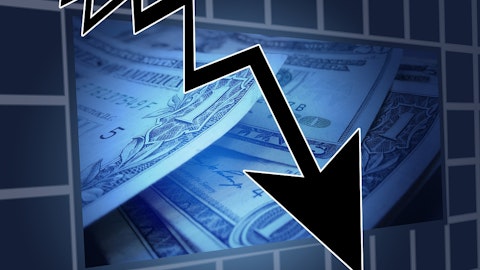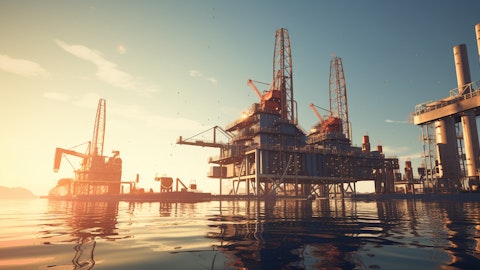Clay Gaspar: Scott, I think it’s really the well mix. We have got some wells coming on, the Williston wells are exceptionally high oil cut. We continue to bring those in. I think that’s just working in our favor in that regard.
Scott Gruber: Okay. And I appreciate it. Thank you.
Clay Gaspar: Thanks sir.
Operator: Our next question comes from Scott Hanold from RBC. Scott, your line is now open.
Scott Hanold: Yes. Thanks. If I can delve into the infrastructure a little bit more. On Page 13, you obviously bucket three areas that you are focused on in terms of building support for the 2024 plan. As you think about the Permian development over the next 2 years, 3 years, 4 years, like which area really are you focused most primarily on to make sure you are executing on the plan? Like where do you see the risk of the biggest constraint, I guess is the question?
Clay Gaspar: Scott, is all of the above an option. No, I mean seriously, any one of these things gets constrained and you are dead in the water, or at least constrained. And so we work really hard to not just build what is the best rate of return opportunity set in our portfolio, but we are very thoughtful about modeling our own infrastructure, even modeling third-party infrastructure if we don’t feel that they do an adequate job. And then there is the occasional curve ball where one of the third-parties maybe even in the electrification front, can’t come through with their normal pace. We need to have enough flexibility, enough forethought, enough creativity to be able to solve some of those problems essentially for them.
So, one of the things I mentioned is building out more of our own electrical infrastructure. We have about 700 miles of electric lines in our basin already. We generate some of our own power. We have our own micro grids. And this is really taking the bull by the horns out of necessity, because otherwise, the local power providers were not going to be able to keep up. So, those are the kind of proactive steps that we really leaned in probably with double effort in ‘23 because some of these historical norms have really changed, and we want to make sure that we didn’t just bring on a bunch of wells and then be abnormally constrained and have to answer questions about why our wells are so terrible. So anyway, I feel really good about the work that we did in ‘23 that we continue to do in ‘24, but look, we are not out of the woods.
We continue to look at infrastructure needs in ‘26, ‘27 and ‘28. We are working with partners as best we can, and I really think we have a great runway ahead of us. But the team is always on caution to make sure that we are prepared for those unforeseen challenges.
Scott Hanold: Okay. Thanks for that. And as my follow-up, it’s going to be on M&A. And I was hoping to get a deeper sense of how you think about M&A. And it’s really two parts. One, first, if you can comment on some of the recent deals that have been out there, if you all participated and really what was the gives and takes of why – if you did, why Devon didn’t went out. And then number two, you all mentioned obviously, you are a multi-basin player, but like when you think about like does Devon have the scale right now that it would like? And if you were to add, would it be really most a Permian thing, or are other of those basins open to more significant M&A for Devon?
Rick Muncrief: Yes, it’s Rick. I will field that one. Number one, I really like the scale that we currently have. We have a deep resource base across our five basins that we are in. So, I feel really good about that. Now, we are always – as I mentioned earlier, we are always going to be looking to be opportunistic to add resource, to add investment opportunities at a reasonable value, at an attractive value for our shareholders. I think that’s just really incumbent upon this management team to always being on the hunt there. That being said, we are going to be very disciplined. Some of the recent transactions, I think that were out there that were announced. When I look at the metrics on those, those were rich, it really were.
And others, there have been a couple of them that were hats off, very nice deals that we certainly weren’t participating in those processes, but good for them. And that’s great, congratulations. But for us, I want to just continue to drive on the point. We are going to continue to be disciplined and we have to balance short-term accretion with long-term, how that fits in for the long haul for Devon. We are a 50-year-old company. We are not a 5-year-old company. And we have to be really, really thoughtful about that. And so we will continue to look for opportunities, but we are going to maintain that discipline. And at the end of the day, we have a deep, deep resource base. And I think that’s something that, that is incumbent upon this management team that we have to continue to drive home and we have to demonstrate not only how we execute, hitting numbers, exceeding whatever that is, but we just have to do a wonderful job in working with the outside community, outside investors on the resource that we have in-house currently.
Scott Hanold: And regionally, is there an area you focus a little bit more time on? Is it Permian, Bakken, Eagle Ford, like are all areas of focus?
Rick Muncrief: I think for us, we are going to stick to our strategy. It’s real simply put. We want to stay as oily as we can for as long as we can. And I think we are seeing that play out in real time with – I am not sure we got where gas prices are as we sit here this morning again, but it’s up $2. That’s not a good spot to be in. And so for us, we want to stay as oily and as liquid rich as we possibly can because throughout the entirety of my career, that’s been the place to go. Now, we are all – I think we all are optimistic about what the future of natural gas could be. And we spent quite a bit of time in D.C. talking about the importance of tone, the importance of consistency with some of our public policy, those sorts of things, and then our foreign trade policies.
And so we – so for us, I think near-term, to answer your question, we are going to be very interested in oil-prone basins. Oil is going to drive the margins for the foreseeable future, and that’s kind of where we want to be.
Scott Hanold: Thanks for the color.
Rick Muncrief: You bet.
Operator: Our next question comes from Charles Meade from Johnson Rice. Charles, you may proceed with your question.
Charles Meade: Good morning Rick, Clay and Jeff. Rick, I want to ask a question about your Delaware Basin completion crews. And more specifically, if you could give us a sense of the composition of the four fleets you are running right now, whether those are all zipper fracs or whether there is any some are frac crews in there? And we are – in the bigger sense, where I am going with this, has there been any thought or is there any possibility of adjusting that mix to – so that you are more on a steady state program there?
Rick Muncrief: Yes. I am going to let Clay answer the balance of that. But just in real time, just yesterday, I was talking to our – one of our completion managers down there and we are picking up the fourth crew as we mentioned, but the three that have been out there, the – it’s incredible, Charles, on the efficiencies and what we are doing out there. The number of stages and it’s interesting, there is – it’s healthy competition between the team members and certain of the companies that are involved with it and we are actively comparing and contrasting ways that we can get better and better. And at the end of the day, we want to make sure that we do this very, very safely and efficiently. And so we are constantly changing every pad has its unique characteristics.
But I can tell you that more and more, we just see these efficiencies that are just incredible. And things that just 12 months ago, we knew that you would see some efficiencies, but we are exceeding some expectations. Clay, why don’t you maybe some follow-up Charles.
Clay Gaspar: We have more simul frac coming – we are completing today, and more to come throughout the year and go forward. One of the challenge of simul frac, you really need to plan that 12 months or 18 months ahead when you are planning the well site location, how many wells on one particular location, because that enables more ability to do some of that. So, about 12 months ago, we started really kind of leaning in, building a little bit larger number of wells per pad instead of separate pads. That allows more simul frac opportunity, which we are seeing great results, and we are continuing to benefit from. We are also testing some very interesting things where we artificially tie pads together with some big lines between the two.
So, there is some really creative stuff. But again, it’s a little below the radar, typically of what we talk about on earnings calls. But I can tell you that the teams are doing just amazing work and really adding material value through these efficiencies to the bottom line of Devon. So, really appreciate the great work there.
Charles Meade: Got it. And then, Clay, I want to go back to your prepared comments, you were talking about – I think I heard you talk about some additional landing zones in the Wolfcamp B, and I am not sure I kind of – I caught it all when you were talking about it. So, I was wondering if you could elaborate a bit on that and perhaps including your answer, an indication, is this something that you are going to be – that you are working into the ‘24 program, or is this an out-year sort of project?
Clay Gaspar: Yes. I think sometime last year, we are deep in the penalty box. We talked about the highlights of some of the great work that the team did around understanding the Wolfcamp B. Now, that work is manifesting and more of that be coming to kind of that front end of the priority list, really competitive, super accretive, and we are incorporating that landing zone into some of the development that we have during the course of ‘24 and beyond. And so here is how I would characterize it. This is landing zones that we knew were viable. We needed to test. We needed to understand. We needed to try some different configurations to really find the best approach. During the course of ‘22 and ‘23, we did that. We optimized a development approach.
And now in ‘24, we are benefiting from some of that. So, again, it probably was lost in some of the shuffle last year, but this is work that we did during the course of ‘23 that we are significantly benefiting from. This expands what I would consider some of our really Tier 1 runway. It’s stuff that was a little further out in the priority on a risk basis as we de-risked it what it really has moved to the front of the pack, and we are really excited about the continued good work there.
Charles Meade: Thanks for added detail.
Clay Gaspar: You bet.
Operator: [Operator Instructions] And our next question comes from David Deckelbaum from Cowen. David, your line is now open.
David Deckelbaum: Thanks for squeezing me in guys. I appreciate the time. Rick or Clay, I wanted to ask just, you talked about – Rick, obviously or Clay, the total dollar amount for the Delaware actually coming down this year, it looks like you are still obviously growing that asset. You guided obviously to a slight decline, I guess at a corporate level, I am wondering, when you think about capital allocation, should we be consistently thinking about the Delaware as a growth asset over the next several years, given the visibility that you have now where you can be allocating capital to within that basin?
Clay Gaspar: I think it’s – I would put it in the same category as Devon. We are a low growth kind of zero to 5%. Delaware will play a certain role. Some quarters, some years, it’s going to be a little bit of a tick up. Others, it’s going to be relatively flat. But I wouldn’t think of it as a standout growth asset. We are really pleased with the year-over-year performance. As I mentioned, it did grow. We also were able to build a few extra DUCs during the course of the second half of last year that we were able to capture the benefit of in the first half of this year. So, there is kind of that going on in the background. But I wouldn’t say it’s materially out of step with overall Devon or with the other basins.
Rick Muncrief: Hey David, it’s Rick. I will add that when we talk about it being flat to up slightly in the Delaware, that’s on the oil side. And as you think about an improving – structurally improving gas and NGL structure, you will see growth there. So, I think you can look at it from an equivalent standpoint, it is a growth basin and it’s going to continue to be. That’s what drove a lot of our 8% growth as a company last year. And so I think you are going to see that continue to play out. That’s not only true of us. That’s true of the entire Permian Basin, whether it’s on the Midland side or the Delaware side, you are going to continue to see gas production, NGL production continue to grow even in a flat oil scenario.
David Deckelbaum: Thanks Rick and Clay. And maybe just Rick, one of the, I guess other parts of the capital budget that continues to grow every year, albeit still small as carbon capital. In a world where you are trying to enhance returns of capital to shareholders, could you kind of contextualize how you see that spend generating returns for Devon as a whole and why that’s sort of seeing a larger piece of the pie this year, albeit small?
Rick Muncrief: Yes. I think it’s a really good question, and it’s a really important topic for us, only as Devon, but as an industry, and it’s something we are going to stay ahead of. We have changing regulations. Devon wants to make sure that we stay ahead of the curve. And these regulations are coming at us quickly. What a lot of people don’t understand is some of these regulations coming are so onerous that many of the low-volume wells that we have across this nation are going to end up being plugged. And so you are going to see oil and natural gas wells that basically are stripper wells, as we always reform to that are such a low volume. They just quite honestly, they cannot afford to spend capital on. And it’s just – it’s going to be a fact of life.
And so there are studies by API and some of the other trade groups talk about that impact, but it is real. So, what Devon wants to do, we want to make sure that we are ahead of the curve, as I have said, and it’s something that we will – I think you will see over time is going to continue to creep up for the next 2 years or 3 years. We want to be very thoughtful about that and prudent with it and strategic about it. But it is something to – that we all just have to deal with. It’s a fact of life.
David Deckelbaum: And just for my own edification, is that capital being earmarked for projects that would allow you to prolong production on some of these wells such as increasing methane capture, or is this capital associated were tied to plugging and abandoning some of those wells that would be more regulatory headaches?
Clay Gaspar: David, what I would characterize most of it is, is retrofitting in existing facilities with better designs to lower emissions. And by the way, keep us well ahead of this coming regulation wave. So, you could look at this out of necessity. I think we are half a click ahead. We try and stay well ahead of just necessity. But these are regulations that we will always make sure that we are staying in front of to continue to reserve our important rights as an organization to provide energy to fuel the world. So, thanks again for the question, David.
David Deckelbaum: Thanks guys.
Scott Coody: Well, it looks like we have run a little bit past time here. So, I appreciate everyone’s interest in Devon today. And if you have any further questions, please don’t hesitate to reach out to the Investor Relations team at any time. Have a good day everyone.
Operator: Ladies and gentlemen, this concludes today’s call. Thank you for joining. You may now disconnect your lines. Thank you.
